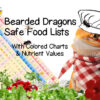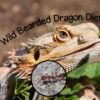Yellow fungus in bearded dragons is often picked up on by pet owners when their bearded dragons skin is yellow, brown or black in patches, but what exactly is it?
Article by Dr. Donald Buchanan, companion animal veterinarian practicing in Nova Scotia, Canada.
CANV (Chrysosporium anamorph of Nannizziopsis vriesii) is a fairly newly defined pathogen implicated in a fungal infection commonly known as “yellow fungus disease”. The name yellow fungus disease comes from the yellow – brown discoloration of infected skin.
Note that although the causative agent was believed to be Chrysosporium anamorph of Nannizziopsis vriesii (CANV), it may be shifting towards N guarroi.
CANV belongs to a group of fungi which are keratinophilic – meaning that it likes to grow on keratin (the stuff that scales are made of). These infections are becoming more common over the last several years, originally identified in North America, then into Europe, and now as far reaching as Australia.
Over this time, the causative agent has undergone several name changes as microbiologists’ study deeper into the disease. Yellow fungus disease is fairly well documented now in several species of reptiles. It is particularly devastating to bearded dragons, often being fatal.
- Beginning Stages of Yellow Fungus
- Causes of Yellow Fungus Disease
- Bearded Dragon Has Yellow Skin and Other Symptoms
- How do you Treat Yellow Fungus in Bearded Dragons?
- Will my Bearded Dragon Die from CANV?
- Highly Contagious Disease
- Can I Catch Yellow Fungus From My Bearded Dragon?
- How do you Get Rid of CANV in Bearded Dragons?
- References
Beginning Stages of Yellow Fungus
Yellow fungus disease, or CANV, is a primary pathogen. This means that it can act alone in causing disease. Yellow fungus disease (YFD) gets its name from the yellow to yellowish brown skin color it causes.
The fungus can affect perfectly healthy bearded dragons at any time. However, there are some predisposing factors to consider.
Causes of Yellow Fungus Disease
Causes and conditions that may increase an individual’s susceptibility to yellow fungus disease infection include:
- Stress.
- Overcrowded conditions
- Unsanitary conditions, poor cleaning program
- Inadequate nutrition
- The skin barrier is particularly important. Open skin lesions including trauma, bite or scratch wounds, even an injured toenail are significant risks, as they provide an entry-point for CANV.
It is believed that an asymptomatic carrier state exists where a seemingly healthy lizard can be the source of infection.
The beginning stage of yellow fungus disease is when it enters through the skin, feeding on keratin within the scales. As the infection matures, it may spread over the skin, resulting in more lesions, randomly dispersed over the skin. Given time, the infection will spread deeper, invading the fat and muscle layers, eventually affecting lungs, liver and spleen.
These individuals are dealing with systemic fungal disease, and are very sick, they carry a very poor prognosis. Unfortunately, the extent of an infection may not be readily identifiable by external observation. Many deeper infections are diagnosed via postmortem examination.
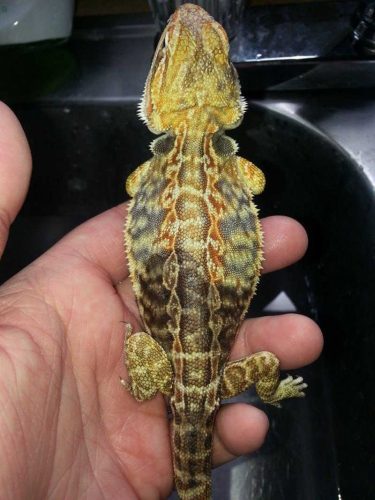
Bearded Dragon Has Yellow Skin and Other Symptoms
The most obvious symptom many will see are the bearded dragons skin turning yellow and progresses towards black over time. Symptoms of yellow fungus in bearded dragons may include:
- Abnormal shedding. Often one of the first signs. Affected areas look like an incomplete shed; affected individuals may shed more often. Crusting of the skin. Often beginning with only a few scales – crusts may present as a yellow or tan colour. Any area of the body may be affected.
- Swelling. Swelling of the immediate area of infection is possible, but may affect a whole limb.
- Ulceration. the outer layer of skin may slough off resulting in a raw, exposed area
- Blunting of scales. Scar tissue will look flattened, with notable loss of normal scale architecture.
- Hyperpigmentation, or darkening of scales. In time, the yellow – tan areas may appear darkened and black, indicating chronicity of infection
- Hyperkeratosis, or roughening of scales. As the inflammation persists, the skin may gain a roughened appearance
- Necrotic patches. Skin may become necrotic (non viable, or dead) It is important that these lesions be debrided – in some cases that means limb amputations.
- Anorexia. Affected animals may lose appetite as the infection internalizes.
- Stunted growth. As with any systemic disease, sub-optimal growth may be an easy indicator that something is wrong.
- Pathologic fractures. Deep infections can spread beyond the skin and to the bone – particularly around the mouth and limbs. Infected bone can be very brittle, and will break easiest – even though gentle “routine” manipulation.
- Lethargy. As the disease progresses, general signs of being unthrifty will present.
- Death. CANV kills bearded dragons.
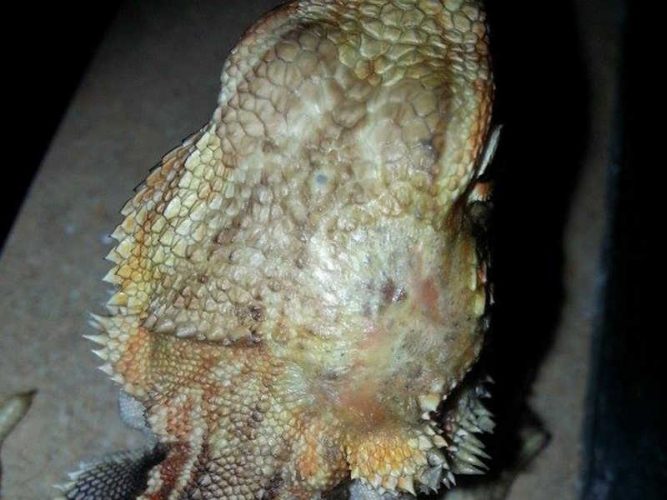
How do you Treat Yellow Fungus in Bearded Dragons?
To treat yellow fungus disease in bearded dragons:
- Call your vet to book an appointment.
- There are a few things you can do at home while you wait for your appointment.
– Isolate your affected bearded dragon, yellow fungus (CANV) is a highly contagious disease.
– Chlorhexidine soap diluted to 4% may be useful to begin treating the infection topically. Chlorhexidine soap can be purchased at chemists or pharmacies.
– Minimize environmental stress. No unnecessary handling, movement near the cage or any other activity that could lead to stress.
– Keep the enclosure to an ideal standard. Cleanliness (see post on cleaning) is extremely important. - During your vet visit, a full history will be taken and your vet will conduct a thorough physical exam.
Unfortunately, yellow fungus disease cannot be diagnosed by physical exam alone, as the lesions often look similar to other common problems (trauma, bacterial skin infections, and burns).
For a definitive diagnosis, a skin biopsy is needed. The animal is sedated while the veterinarian performs a full thickness skin biopsy.
Ideally, this sample is sent to a lab for a fungal culture (to grow out the causative agent), histopathology (examination of the sample under the microscope), and PCR or polymerase chain reaction (a highly specific DNA sequencing test).
Although recommended, extensive testing is not always possible, and a presumptive diagnosis may be made on a case by case basis. - Early lesions do not always look significant, and bearded dragons are often brought in late in the course of the disease. Because of this, further testing may be required to assess the overall health status of the animal.
These tests may include bloodwork, or x-rays. Some cases of CANV affect animals because their immune system is impaired, placing more weight on systemic diagnostic testing. - As we have already covered, the infection is likely more than just skin deep. Because of this, topical medication alone is not enough. Treatment involves the use of a systemic (oral or injectable) antifungal drug.
Three drugs have been studied including:
– ketoconazole,
– itraconazole, and
– voriconazole.
Systemic antifungals are not without their downsides – they can be harmful to the liver of bearded dragons and tend to be fairly costly. Of these three drugs, studies have shown that voriconazole may be the safest. - Combining a systemic antifungal with topical adjunctive treatment may be beneficial and are often necessary after a biopsy is performed. Topical treatments alone are not adequate for treatment of yellow fungus disease.
Systemic antifungal medication should be seen as the primary treatment. Some examples of commonly used topical agents include terbinafine, chlorhexidine, and silver sulfadiazine. - Debridement of the affected area can be beneficial as well. This means removing the damaged, or necrotic tissue.
Necrotic tissue is non-viable – It has lost its’ blood supply, and therefore, systemic drugs have no way to penetrate this tissue. The fungus will reside within and feed on this dead tissue. Although debridement may be done at home, I strongly advise seeking the help of a veterinarian to demonstrate how to safely approach this procedure. - Treatment is required for several weeks.
- The fungal infection may reach “remission” but is unlikely ever to be fully cleared. Treatment may provide comfort and quality of life to affected animals.
Will my Bearded Dragon Die from CANV?
At this time, the vast majority of bearded dragons afflicted by yellow fungus disease will die from the condition, or side effects from the medication used.
Death usually occurs within a few months, but varies greatly between individuals. One report of four bearded dragons infected with CANV resulted in euthanasia within 6 months. Prognosis will change drastically depending on how severely the individual is affected.
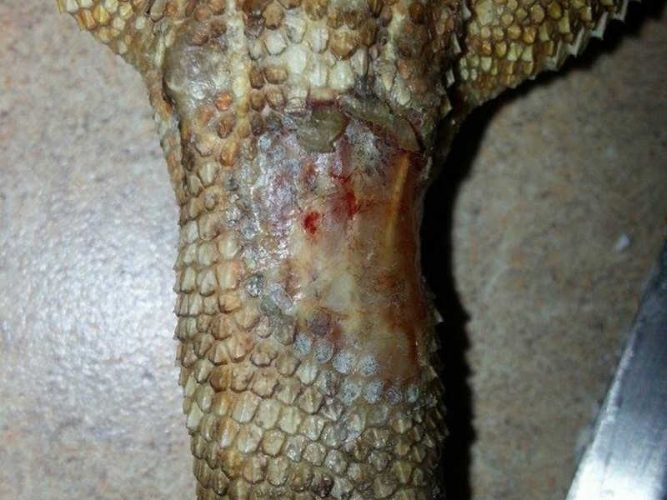
Highly Contagious Disease
Yellow fungus (CANV) is a highly contagious disease easily passed between individuals in the same household. The fungus is passed in several ways:
- Direct contact between individuals,
- Through the air,
- On surfaces, or on the skin and clothes of a handler.
This means you need to put in place quarantine practices to ensure the disease is not spread between reptiles.
Can I Catch Yellow Fungus From My Bearded Dragon?
CANV is not believed to be zoonotic. It is unlikely you can catch yellow fungus from your bearded dragon however immunocompromised individuals may be susceptible to Nannizziopsis spp.
Cases of CANV in humans have been found to be caused by a different specifies of Nannizziopsis than the one found in reptiles.
Consult with your doctor if you are unsure or if you are likely to come in contact with immunocompromised individuals.
How do you Get Rid of CANV in Bearded Dragons?
Although recent studies are promising, it is not yet possible to fully and reliably eradicate CANV. Once an animal has been infected, it cannot be cleared. This is why isolation is recommended.
As with many conditions, treatment proves very difficult, and often unrewarding, so we tend to focus on prevention.
- Quarantine new additions to your bearded dragon population.
- Avoid undue stress and handling.
- Ensure cleanly environment. It is vital to reduce the fungal load in the environment as quickly as possible and keep it down which is done by cleaning. See post on cleaning. This includes replacing substrates.
- Proper diet.
- Proper lighting, temperature and humidity are essential. Ensure your setup is right, see the post on setting up your lighting and heating or the humidity post. Low ambient temperatures have been connected with infection.
- Frequent hand washing will help prevent transmission. At this time, CANV is not believed to be zoonotic, and thus poses no risk to the human population, although proper hand washing is always recommended.
References
- Abarca ML, Martorell J, Castella G, Ramis A, Cabanes FJ (2009) Dermatomycosis in a pet inland bearded dragon (Pogona vitticeps) caused by a Chrysosporium species related to Nannizziopsis vriesii. Vet Dermatol 20: 295–299. https://doi.org/10.1111/j.1365-3164.2009.00736.x
- Bowman MR, Paré JA, Sigler L, Naeser JP, Sladky KK, et al. (2007) Deep fungal dermatitis in three inland bearded dragons (Pogona vitticeps) caused by Chrysosporium anamorph of Nannizziopsis vriesii. Med Mycol 45: 371–376. https://doi.org/10.1080/13693780601188610
- Cabañes FJ, Sutton DA, Guarro J (2014) Chrysosporium-Related Fungi and Reptiles: A Fatal Attraction. PLoS Pathog 10(10): e1004367.Mitchell MA, Walden MR (2013) Chrysosporium anamorph Nannizziopsis vriesii: an emerging fungal pathogen of captive and wild reptiles. Vet Clin North Am Exot Anim Pract 16: 659–668. https://doi.org/10.1371/journal.ppat.1004367
- Van Waeyenberghe L, Baert K, Pasmans F, van Rooij P, Hellebuyck T, et al. (2010) Voriconazole, a safe alternative for treating infections caused by the Chrysosporium anamorph of Nannizziopsis vriesii in bearded dragons (Pogona vitticeps). Med Mycol 48: 880–885. https://doi.org/10.3109/13693781003743122
- WHA Fact Sheet: Yellow fungus and related diseases in Australian reptiles. Wildlife Health Australia. December 2018



